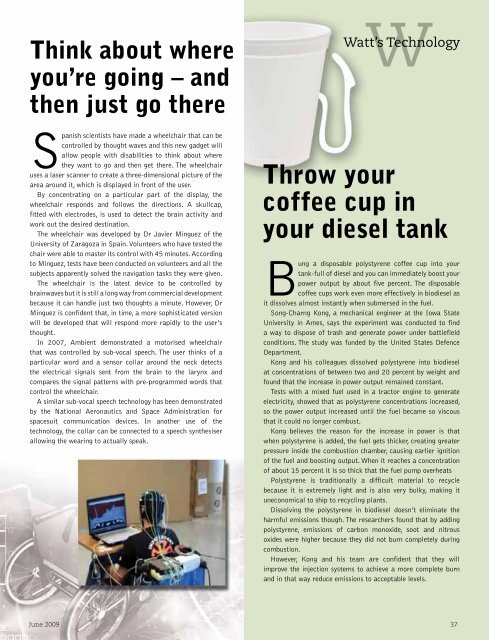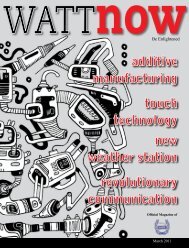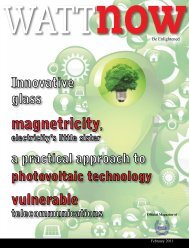download a PDF of the full June 2009 issue - Watt Now Magazine
download a PDF of the full June 2009 issue - Watt Now Magazine
download a PDF of the full June 2009 issue - Watt Now Magazine
- No tags were found...
Create successful ePaper yourself
Turn your PDF publications into a flip-book with our unique Google optimized e-Paper software.
Think about whereyou’re going – and<strong>the</strong>n just go <strong>the</strong>reSpanish scientists have made a wheelchair that can becontrolled by thought waves and this new gadget willallow people with disabilities to think about where<strong>the</strong>y want to go and <strong>the</strong>n get <strong>the</strong>re. The wheelchairuses a laser scanner to create a three-dimensional picture <strong>of</strong> <strong>the</strong>area around it, which is displayed in front <strong>of</strong> <strong>the</strong> user.By concentrating on a particular part <strong>of</strong> <strong>the</strong> display, <strong>the</strong>wheelchair responds and follows <strong>the</strong> directions. A skullcap,fitted with electrodes, is used to detect <strong>the</strong> brain activity andwork out <strong>the</strong> desired destination.The wheelchair was developed by Dr Javier Minguez <strong>of</strong> <strong>the</strong>University <strong>of</strong> Zaragoza in Spain. Volunteers who have tested <strong>the</strong>chair were able to master its control with 45 minutes. Accordingto Minguez, tests have been conducted on volunteers and all <strong>the</strong>subjects apparently solved <strong>the</strong> navigation tasks <strong>the</strong>y were given.The wheelchair is <strong>the</strong> latest device to be controlled bybrainwaves but it is still a long way from commercial developmentbecause it can handle just two thoughts a minute. However, DrMinguez is confident that, in time, a more sophisticated versionwill be developed that will respond more rapidly to <strong>the</strong> user’sthought.In 2007, Ambient demonstrated a motorised wheelchairthat was controlled by sub-vocal speech. The user thinks <strong>of</strong> aparticular word and a sensor collar around <strong>the</strong> neck detects<strong>the</strong> electrical signals sent from <strong>the</strong> brain to <strong>the</strong> larynx andcompares <strong>the</strong> signal patterns with pre-programmed words thatcontrol <strong>the</strong> wheelchair.A similar sub-vocal speech technology has been demonstratedby <strong>the</strong> National Aeronautics and Space Administration forspacesuit communication devices. In ano<strong>the</strong>r use <strong>of</strong> <strong>the</strong>technology, <strong>the</strong> collar can be connected to a speech syn<strong>the</strong>siserallowing <strong>the</strong> wearing to actually speak.W<strong>Watt</strong>’s TechnologyThrow yourc<strong>of</strong>fee cup inyour diesel tankBung a disposable polystyrene c<strong>of</strong>fee cup into yourtank-<strong>full</strong> <strong>of</strong> diesel and you can immediately boost yourpower output by about five percent. The disposablec<strong>of</strong>fee cups work even more effectively in biodiesel asit dissolves almost instantly when submersed in <strong>the</strong> fuel.Song-Charng Kong, a mechanical engineer at <strong>the</strong> Iowa StateUniversity in Ames, says <strong>the</strong> experiment was conducted to finda way to dispose <strong>of</strong> trash and generate power under battlefieldconditions. The study was funded by <strong>the</strong> United States DefenceDepartment.Kong and his colleagues dissolved polystyrene into biodieselat concentrations <strong>of</strong> between two and 20 percent by weight andfound that <strong>the</strong> increase in power output remained constant.Tests with a mixed fuel used in a tractor engine to generateelectricity, showed that as polystyrene concentrations increased,so <strong>the</strong> power output increased until <strong>the</strong> fuel became so viscousthat it could no longer combust.Kong believes <strong>the</strong> reason for <strong>the</strong> increase in power is thatwhen polystyrene is added, <strong>the</strong> fuel gets thicker, creating greaterpressure inside <strong>the</strong> combustion chamber, causing earlier ignition<strong>of</strong> <strong>the</strong> fuel and boosting output. When it reaches a concentration<strong>of</strong> about 15 percent it is so thick that <strong>the</strong> fuel pump overheatsPolystyrene is traditionally a difficult material to recyclebecause it is extremely light and is also very bulky, making ituneconomical to ship to recycling plants.Dissolving <strong>the</strong> polystyrene in biodiesel doesn’t eliminate <strong>the</strong>harmful emissions though. The researchers found that by addingpolystyrene, emissions <strong>of</strong> carbon monoxide, soot and nitrousoxides were higher because <strong>the</strong>y did not burn completely duringcombustion.However, Kong and his team are confident that <strong>the</strong>y willimprove <strong>the</strong> injection systems to achieve a more complete burnand in that way reduce emissions to acceptable levels.<strong>June</strong> <strong>2009</strong> 37
















